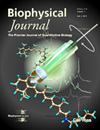不同的构象集合定义了蛋白激酶共享的折叠-变构景观。
IF 3.1
3区 生物学
Q2 BIOPHYSICS
引用次数: 0
摘要
酶家族成员之间的序列差异有助于不同的集合行为,这微妙地影响底物亲和力,选择性和调控。一个典型的例子是真核蛋白激酶(EPKs)家族,它调节许多细胞过程并作为重要的药物靶点。在这里,我们通过基于结构的统计力学框架对274个epk进行meta分析,剖析了序列变化对折叠构象景观的影响。我们发现epk在其天然集合中填充了几个部分结构状态,在n端叶中具有结构顺序的层次结构,这对催化和激活至关重要。尽管如此,(非)折叠机制在大多数激酶中是唯一保守的,n端叶首先展开。由于活性位点残基与远端位点(包括已建立的变构口袋)之间的强耦合,激酶激活以非保守的方式调节了局部稳定性和热力学连通性。我们进一步展示了活化如何以渐变的方式驱动Abl激酶集合向更折叠和热力学耦合的系统发展。我们的工作揭示了激酶的热力学设计原理,同时揭示了在类似物中序列变化对集合行为的影响程度。本文章由计算机程序翻译,如有差异,请以英文原文为准。
Diverse Conformational Ensembles Define the Shared Folding-Allosteric Landscapes of Protein Kinases.
Sequence variation across members of an enzyme family contributes to diverse ensemble behaviors, which subtly influence substrate affinity, selectivity and regulation. A classic example is the family of eukaryotic protein kinases (EPKs), which regulate numerous cellular processes and serve as important drug targets. Here, we dissect the consequences of sequence variation on the folding-conformational landscapes by performing a meta-analysis of 274 EPKs through a structure-based statistical mechanical framework. We find that EPKs populate several partially structured states in their native ensemble with a hierarchy of structural order in the N-terminal lobe that is critical for catalysis and activation. Despite this, the (un)folding mechanism is uniquely conserved across the majority of kinases, with the N-terminal lobe unfolding first. Kinase activation modulates the local stability and thermodynamic connectivity in a non-conserved manner and across the entire structure, due to the strong coupling between the active site residues to distant sites, including the established allosteric pockets. We further show how activation drives the Abl kinase ensemble towards a more folded and thermodynamically coupled system in a graded manner. Our work uncovers the thermodynamic design principles of kinases with insights into allostery, while shedding light on the extents to which ensemble behaviors are impacted by sequence variations in paralogs.
求助全文
通过发布文献求助,成功后即可免费获取论文全文。
去求助
来源期刊

Biophysical journal
生物-生物物理
CiteScore
6.10
自引率
5.90%
发文量
3090
审稿时长
2 months
期刊介绍:
BJ publishes original articles, letters, and perspectives on important problems in modern biophysics. The papers should be written so as to be of interest to a broad community of biophysicists. BJ welcomes experimental studies that employ quantitative physical approaches for the study of biological systems, including or spanning scales from molecule to whole organism. Experimental studies of a purely descriptive or phenomenological nature, with no theoretical or mechanistic underpinning, are not appropriate for publication in BJ. Theoretical studies should offer new insights into the understanding ofexperimental results or suggest new experimentally testable hypotheses. Articles reporting significant methodological or technological advances, which have potential to open new areas of biophysical investigation, are also suitable for publication in BJ. Papers describing improvements in accuracy or speed of existing methods or extra detail within methods described previously are not suitable for BJ.
 求助内容:
求助内容: 应助结果提醒方式:
应助结果提醒方式:


